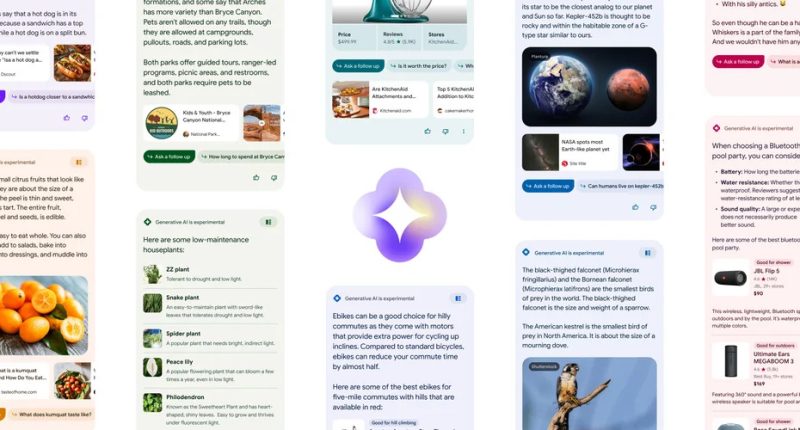If you haven’t seen the meme factory already, Google’s I/O conference this year was full of announcements on AI (especially generative AI) developments and features. Now, a few weeks after the conference, the company has started to make good on its promises. The tech titan announced in a blog post that it has started to open up access to new generative AI capabilities in Search. Among these, it is opening up access to Search labs – a programme that allows users to sign up for experiments on its search features– and it is rolling out the new AI/LLM-powered Search Generative Experience (SGE) to users that signed up for it.
“This experiment is our first step in adding generative AI to Search, and we’ll be making many updates and improvements over time,” Google wrote in its blog post. “As we continue to reimagine how we can make it even more natural and intuitive to find what you’re looking for, we’re excited for you to test out these new capabilities and share feedback along the way.” Generative AI results will appear in a shaded section below the search bar but above the standard web results.
Google will now test SGE with the limited number of users before introducing them to the wider audiences. The company noted that users who signed up for Search Labs notified by email, informing them when they can start testing the new generative AI features in Search. Once they are part of it, they will have access to Google’s new AI tools and understand how the new generative AI-powered Search experience works. With generative AI, Google can tailor search results to individual preferences and interests.
The introduction of AI-powered generative capabilities holds promising implications for various aspects of search. For instance, users may witness improved natural language understanding, allowing them to ask more complex or nuanced questions and receive accurate and contextually relevant answers. Additionally, the enhanced search experience may empower users to explore related topics and discover valuable insights they might have otherwise missed.
Google’s advancements in generative AI are a clear departure from its original stance on the matter. In the earlier days, it was not so keen to jump on the generative AI wagon, but that changed when Microsoft gained an edge in the AI race by steadily investing in OpenAI. Google responded by quickly churning out Bard – its AI chatbot – but it is yet to reach the glory and fame of ChatGPT.
The Search Generative Experience harnesses the power of AI and large language models (LLMs) to ensure that users can understand a topic faster, as well as get things done quickly and more easily and uncover what it calls “new viewpoints and insights.” By leveraging the potential of generative AI in search, Google aims to deliver more relevant and dynamic search results, providing users with a deeper understanding of their queries and facilitating more meaningful interactions with the information they seek.
Google already aims to make search more visual in essence, and with SGE, the new Search will not be content by simply showing a score of blue links when users search for something. Instead, SGE will utilize generative AI to make information more accessible and understandable to the wider audience. This will be done by generating concise summaries, ‘snapshots,’ or explanations, so that Google (with SGE) can break down complex concepts into digestible formats and enable users to access and comprehend information that may have otherwise seemed overly complicated. This will ensure that users can get a strong grasp of new or complicated topics in a shorter period of time, which could enable them to work more efficiently.
And if this is not enough, the new search experience also comes with a Shopping integration. Google cited an example where users can search for things like “Peel and stick wallpaper for kitchen” to learn about important factors, like if it’s easy to remove, and get a list of options, including price, customer ratings and links to purchase. To know more, they can also select the option to ask follow-up questions of their own, which launches the Conversational mode with a chatbot UI. Like ChatGPT, the Conversational mode will keep in mind the previous questions in order to provide new answers.
Apart from opening up access to other Search Labs, Google is also opening access to Code Tips and Add to Sheets for interested users in the US. For those who need a refresher, Code Tips “harnesses the power of large language models to provide pointers for writing code faster and smarter” to let developers ask how-to questions about programming languages, tools, and algorithms. Add to Sheets, on the other hand, lets users insert search results directly into Google’s spreadsheet app.





